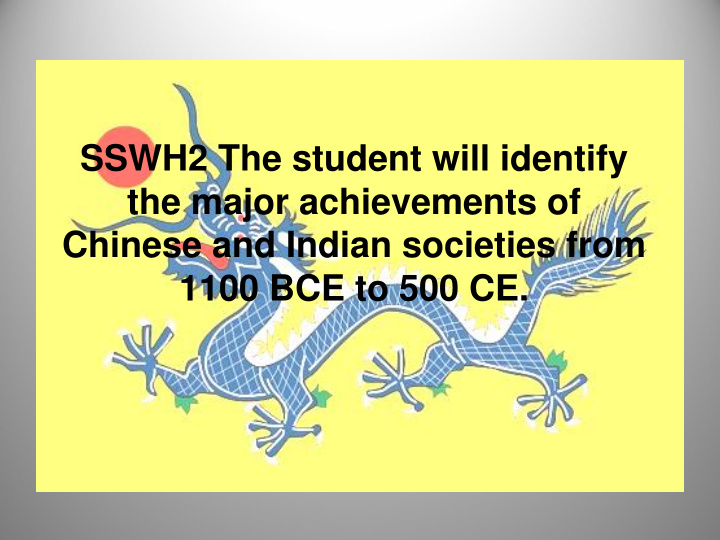



SSWH2 The student will identify the major achievements of Chinese and Indian societies from 1100 BCE to 500 CE.
a. Describe the development of Indian civilization; include the rise and fall of the Maurya Empire, the “Golden Age” under Gupta, and the emperor Ashoka. https://www.youtube.com/watch?v=8Nn5uq E3C9w Crash course #6 World History Text pp. 189-199
a. Describe the development of Indian civilization; include the rise and fall of the Maurya Empire, the “Golden Age” under Gupta, and the emperor Ashoka. • The Maurya Empire began around 321B.C. • After years of fighting, the Empire united northern India for the first time • To hold the empire together, strict rules of government were put in place, which included government spies, assignations, and high taxes
Emperor Ashoka • In 269 BC, Ashoka became the ruler of India and expanded it’s boundaries
Emperor Ashoka • After at first expanding the empire through warfare, Ashoka began to rule by Buddhist teachings: -Toleration and non-violence -Subjects would be treated fairly -Religious toleration * Ashoka created a system of roads throughout India
Emperor Ashoka • Ashoka’s rule failed to hold the empire together • Ashoka’ Buddhists beliefs lasted long past his reign, and spread throughout the region
Gupta • After Ashoka’s death, India fell into 500 years of political turmoil • The Gupta Empire rose up through military conquest and diplomacy • During the Gupta Empire arts, music, literature, and science grew in the cities
b. Explain the development and impact of Hinduism and Buddhism on India and subsequent diffusion of Buddhism. • Hinduism: • Buddhism: -polytheistic religion -founded by Siddhartha (Buddha) -reincarnation and karma -Path to enlightenment -Not traced to one -Attempt to reach founder nirvana, or a release from suffering and -Strengthened the worldly pain caste system through karma -rejected caste system
Hinduism and Buddhism in India • Buddhism attracted many laborers and crafts people who were at the bottom of the caste system • Though missionaries spread the Buddhist religion in India, it never took hold • Trade with other countries and territories helped Buddhism spread else where (East Asia) • Hinduism remained the main religion of India
c. Describe the development of Chinese civilization under the Zhou and Qin. • Zhou (1027-256 BC) • Qin (241-202 BC) -established a feudalistic -formed an autocracy society -standardized all of China -built roads and canals (laws, measurements, currency) -coined money -Great Wall built -used cast iron
c. Describe the development of Chinese civilization under the Zhou and Qin. d. Explain the impact of Confucianism on Chinese culture; include the examination system, the Mandate of Heaven, the status of peasants, the status of merchants, and the patriarchal family, and explain diffusion to Southeast Asia, Japan, and Korea. https://www.youtube.com/watch?v=ylWORyToTo4 World History Text pp.104-109
d. Explain the impact of Confucianism on Chinese culture; include the examination system, the Mandate of Heaven, the status of peasants, the status of merchants, and the patriarchal family, and explain diffusion to Southeast Asia, Japan, and Korea.
Confucius • Confucius wanted to restore peace and harmony to China • He developed 5 codes of relationships between, people, and people and the government • Believed that education was important in helping people grow, and in the running of a government • Confucianism is not a religion, but a way to live • Strict social order and discipline was the key to a successful society
China • Examination System: -originally most government jobs were through appointment -the examination system required citizens to pass a test to earn a position in the government -In theory, it opened up government jobs to the masses
China • Mandate of Heaven: -Royal authority came from heaven -Only wise and just rulers kept the Mandate and their throne -Foolish rulers lost the Mandate and their throne through natural disasters, upheaval, revolts, and inavsions
China • Peasants and Merchants: -Though more wealthy than peasants, merchants were lower on the strict social ladder -Merchants did not contribute to society and were only after their own personal gain -Peasants produced food, which society needed
e. Explain how the geography of the Indian Subcontinent contributed to the movement of people and ideas. • Mountains in the North prevented invasion (positive) and trade (negative) by land • Southern India is surrounded by water, making the transfer of goods much easier
Recommend
More recommend